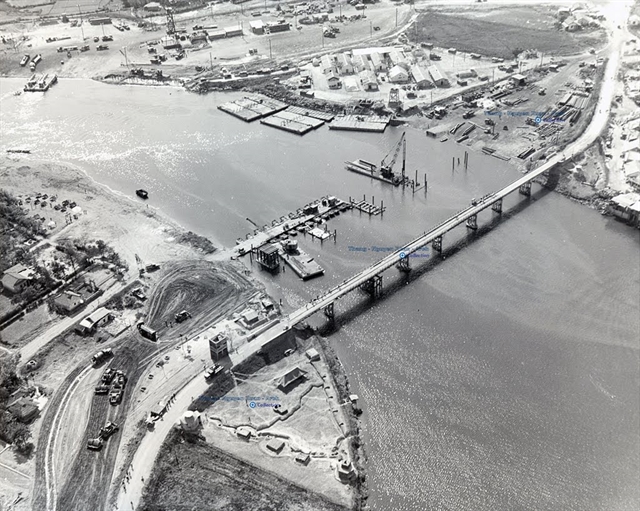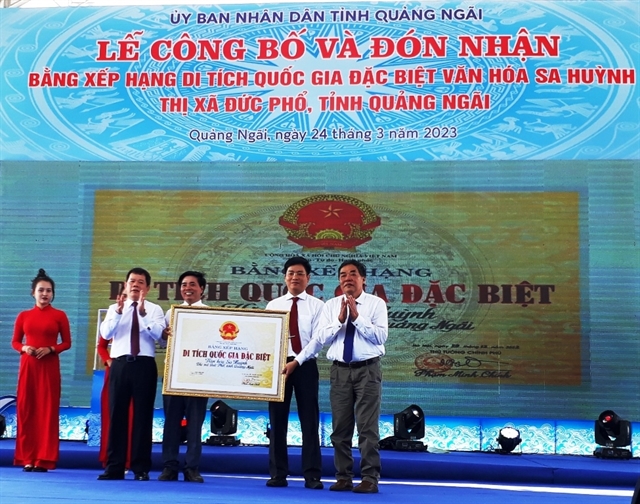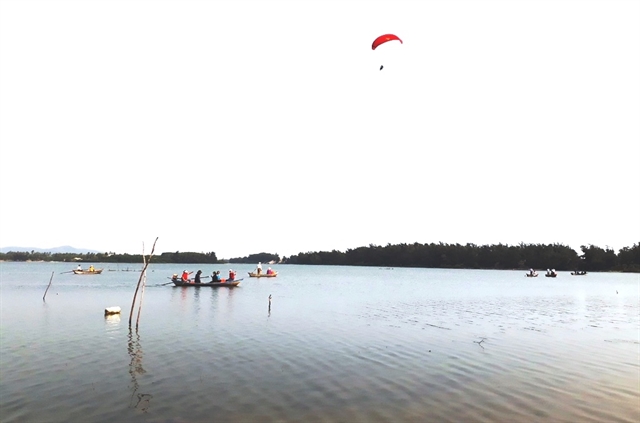 In the Spotlight
In the Spotlight


|
| The Ministry of Culture, Sports and Tourism hands over the certificate of National Special Heritage for the Sa Huỳnh Archaeological Relics in the central Quảng Ngãi Province’s Đức Phổ Town. — Photo courtesy of Lê Văn Công |
QUẢNG NGÃI — Sa Huỳnh Archaeological Relics in Đức Phổ Town, located in the central province of Quảng Ngãi, have been granted the certificate of National Special Heritage by the Ministry of Culture, Sports and Tourism.
This prestigious recognition, signed by the Prime Minister last year, acknowledges the exceptional value of the ancient Sa Huỳnh Culture – one of Việt Nam's three civilisations – that dates back 2,500 to 3,000 years.
Trần Hoàng Tuấn, deputy chairman of Quảng Ngãi Province People's Committee, stated that this was a proud moment for the province as it strives to preserve and safeguard this rare heritage in Việt Nam.
“It’s an honour for the province to preserve and protect a rare heritage in Việt Nam," he said. "Local government and the people will do all the best in promoting the heritage as one of the most precious archaeological relics in Việt Nam and the world.”
“Experts and local authorities have been working hard to explore more sites in the boundary of the relics in boosting the archaeological value and research.”
Sa Huỳnh archaeological site, which covers Phổ Thạnh and Phổ Khánh wards in Đức Phổ Township, 60km south of Quảng Ngãi City, was first discovered by French archaeologist M. Vinet in 1909, and hundreds of burial jars were then found in different excavations in the coastal area of Sa Huỳnh in 1909-1923.
Bùi Văn Liêm, a member of the Việt Nam Archaeology Institute, said vestiges of the Sa Huỳnh Culture were found both in the mainland, sea and islands of the central and Central Highlands regions and Quảng Ngãi was the centre of the Sa Huỳnh Culture.

|
| An Khê Lagoon is believed to have formed during the Flandrian interglacial period 6,000 to 7,000 years ago. The lagoon is a core zone of the National Special Heritage of Sa Huỳnh archaeological sites in Quảng Ngãi Province. — Photo courtesy of Lê Văn Công |
He said many antiquities related to tombs of the Sa Huỳnh Culture had been excavated by Western archaeologists and Vietnamese over 100 years ago when the Sa Huỳnh Culture was discovered in 1909.
Nearly 400 funeral urns were found in the area in 1923 alone, while 26 out of 80 survey sites had been protected as National Relics, including Phú Khương, Gò Ma Vương (Ma Vương Hilllock), Thạnh Đức, An Khê Lagoon, An Khê channel and Champa culture area – in Long Thạnh Village of Phổ Thạnh and Phổ Khánh, according to Liêm.
Liêm said the national heritage council, in cooperation with local authorities, will continue expanding archaeological works in building a file for recognition as UNESCO’s heritage in the coming time.
About 500 documents, antiquities and fragments from excavations in 1909, 1923 and 1978 are displayed at the Sa Huỳnh exhibition halls.
The Sa Huỳnh relic site was included in the Lý Sơn-Sa Huỳnh Global Geo-Park dossier developed by scientists, conservationists and archaeologists in 2015-2021, earning the UNESCO global geo-park recognition. But the plan was then halted by the provincial People’s Committee in 2022.
Last year, the province rejected a solar power project in An Khê Lagoon as it would damage the core zone of the national special heritage.
The 3.5km long and 1km wide An Khê Lagoon is believed to have formed during the Flandrian interglacial period 6,000 to 7,000 years ago. — VNS




